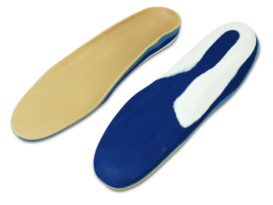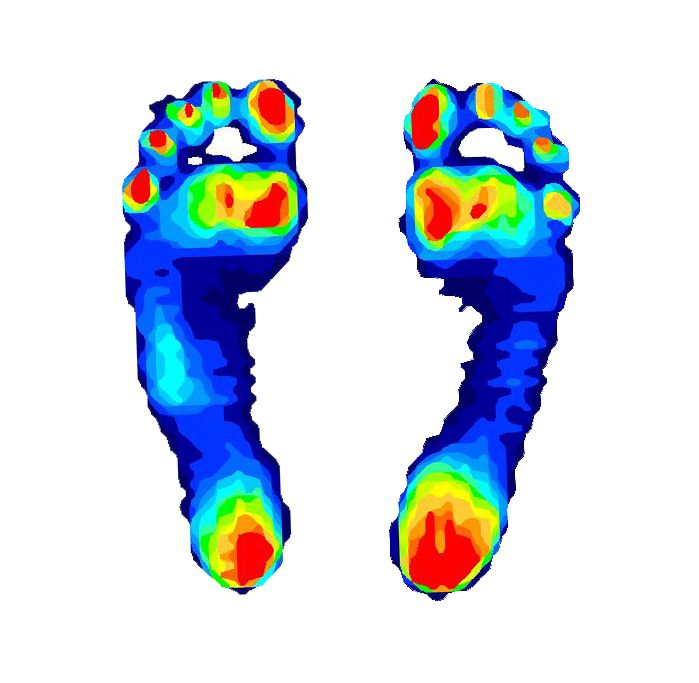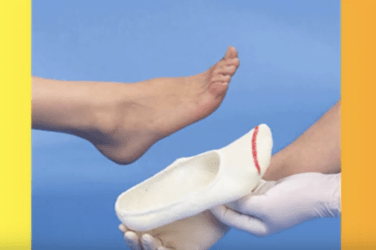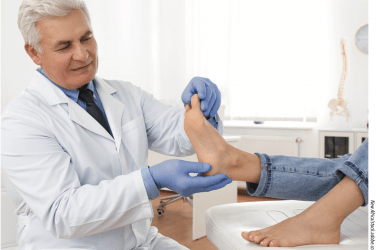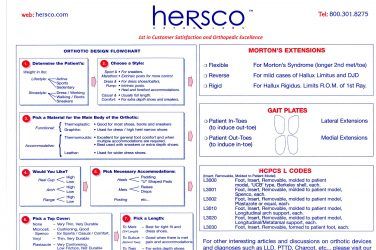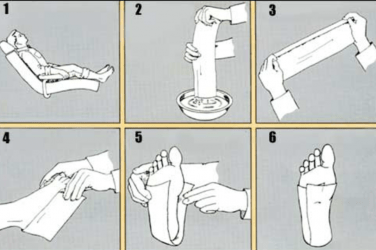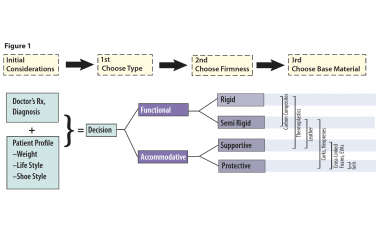The medical terrain continues to change rapidly, and additional overhauls are expected as the Affordable Care Act, accountable care organizations, and other federal initiatives alter the landscape further. To survive, every segment of healthcare will have to justify its value, showing direct links to patient wellness; evidence-based medicine (EBM)-loosely defined as medical practices that rely on modern best evidence, clinical experience, and research studies-is being mandated for each discipline. Accordingly, the O&P profession will need to conduct and compile clear research and studies verifying the efficacy of its interventions.
An earlier article, “The Effectiveness of Foot Orthotics” (The O&P EDGE, July 2011,), outlined 25 scientific papers that demonstrate the benefits of using foot orthotics to treat a variety of conditions. This article builds on that evidence, presenting another 15 studies to further highlight the value of that type of intervention.
Knee Pain
The knee is the largest joint in the body and most people will experience knee pain at some point in their lifetimes. Pain can develop as a result of overuse, a sudden increase in activity, or a systemic disease such as arthritis. One aspect of knee pain that has been studied closely is patello-femoral pain syndrome (PFPS), which is generally described as pain in the anterior knee or around the patella region. It is a complex subject with many subtleties. Due to its prevalence, researchers have closely studied the kinematics of the knee and lower leg to understand motion in walking and running, seeking connections between excessive movement and pathology. Foot orthotics can control foot pronation, ankle motion, and tibial rotation, thereby potentially relieving symptoms associated with PFPS.
References: Knee Pain
1. Saxena, A., and J. Haddad. 2003. The effect of foot orthoses on patello-femoral pain syndrome. Journal of the American Podiatric Medical Association 93 (4):264-71.
This resource presents a retrospective review of 102 patients. At their follow-up visits, 76.5 percent were improved and 2 percent were asymptomatic, showing a significant decrease in the level of pain with orthoses intervention. Although multiple treatment modalities were used for these patients, the results suggest that the use of semi-flexible orthoses is significant in reducing symptoms of [knee pain].
2. Johnston, L. B., and M. T. Gross. 2004. Effects of foot orthoses on quality of life for individuals with patellofemoral pain syndrome. Journal of Orthopaedic and Sports Physical Therapy 34 (8):440-8.
Sixteen subjects with patello-femoral pain who also exhibited signs of excessive foot pronation were studied. All Western Ontario and McMaster Universities Osteoarthritis Index (WOMAC) subscale scores were significantly improved at three months compared with pre-intervention measurements. Conclusion: Custom-fitted foot orthoses may improve patello-femoral pain symptoms for patients who demonstrate excessive foot pronation.
3. Ferrari, R. 2014. A cohort-controlled trial of custom-made foot orthoses in anserine bursitis. Journal of Prosthetics and Orthotics 26 (1):33-7.
The aim of this study was to determine the proportion of subjects (n = 69) reporting recovery from anserine bursitis [medial knee pain] with prescribed custom-made foot orthoses in addition to local corticosteroid injection versus injection alone…. The addition of custom-made foot orthoses to local injection seems to improve the short- and long-term outcomes (88 percent of the study group versus 41 percent of the control group reported recovery at four months) with fewer recurrences.
Postural Control and Balance
Postural control is defined as the act of maintaining, achieving, or restoring a state of balance during any posture or activity. The effects of orthotics on postural control have been studied closely because elderly patients with compromised balance can pay a high price when control is lost. Poor balance has been associated with a risk for falls, and the Centers for Disease Control and Prevention report that one out of three people over age 65 fall each year. Twenty percent of cases in which an elderly person trips result in serious consequences, such as a fracture or head injury.
References: Postural Control and Balance
4. Cobb, S. C., L. L. Tis, and J. T. Johnson. 2006. The effect of 6 weeks of custom-molded foot orthosis intervention on postural stability in participants with > or = 7 degrees of forefoot varus. Clinical Journal of Sport Medicine16 (4):316-22.
In this study, the authors conclude that six weeks of foot orthotic intervention may significantly improve postural stability in subjects with > 7 degrees of forefoot varus both when wearing foot orthotics and when not wearing foot orthotics. (Author’s note: This indicates there may be a learned behavior component associated with orthotic therapy.)
5. Gross, M. T., V. S. Mercer, and F. C. Lin. 2012. Effects of foot orthoses on balance in older adults. Journal of Orthopaedic and Sports Physical Therapy 42 (7):649-57.
Thirteen individuals older than 65 years, who reported at least one unexplained fall during the past year and demonstrated poor balance, participated in the study. The results provide preliminary evidence that [custom] foot orthoses can effect improvement in balance measures for older adults.
6. de Morais Barbosa, C., M. Barros Bértolo, J. F. Marques Neto, I. Bellini Coimbra, M. Davitt, and E. de Paiva Magalhães. 2013. The effect of foot orthoses on balance, foot pain and disability in elderly women with osteoporosis: A randomized clinical trial. Rheumatology (Oxford) 52 (3):515-22.
This study is an evaluation of the effect of insoles with medial arch support and metatarsal pad on balance, foot pain, and disability in 94 elderly women with osteoporosis. Conclusion: Foot orthoses are effective for improving balance and for reducing pain and disability in elderly women. Orthoses can be used as an adjuvant strategy to improve balance and to prevent falls in the elderly.
Inversion Ankle Sprains in Active Adults
Another common injury related to balance is the inversion ankle sprain. Lateral ankle sprains are among the most common injury in sports and account for a significant percentage of total time lost due to injuries. Research supports the use of foot orthotics for improving balance, a key prevention component. The aim is to provide range of motion while engaging the sensor systems on the plantar foot, which allows sufficient time for the body to react when it senses sudden imbalance. Use of an intrinsically balanced, semi-rigid shell with a deep heel cup seems to improve plantar contact and give good mechanical support without blocking motion.
References: Inversion Ankle Sprain
7. Orteza, L. C., W. D. Vogelbach, and C. R. Denegar. 1992. The effect of molded and unmolded orthotics on balance and pain while jogging following inversion ankle sprain. Journal of Athletic Training 27 (1):80-4.
This study examined the effects of using molded orthotics on nine people who had suffered an inversion ankle sprain. During each part of the study, the subjects were tested while they were using a molded orthotic, an unmolded orthotic, and no orthotic in their shoes. Molded orthotics helped to decrease ankle pain during jogging for those with an ankle sprain, but unmolded orthotics did not. These findings suggest that molded orthotics may play a role in the treatment of inversion ankle sprains.
8. Guskiewicz, K. M., and D. H. Perrin. 1996. Effect of orthotics on postural sway following inversion ankle sprain. Journal of Orthopaedic and Sports Physical Therapy 23 (5):326-31.
Orthotic devices have been shown to successfully modify selected aspects of lower-extremity mechanics and enhance foot stability during the support phase of running…. Postural sway with orthotic intervention improved significantly more in injured subjects than in uninjured subjects. Analysis revealed that orthotic intervention significantly reduced postural sway when the platform moved in the medial/lateral plane and inversion/eversion plane. This research suggests that custom-fit orthotics may restrict undesirable motion at the foot and ankle and enhance joint mechano-receptors to detect perturbations and provide structural support for detecting and controlling postural sway in ankle-injured subjects.
9. Ochsendorf, D. T., C. G. Mattacola, and B. L. Arnold. 2000. Effect of orthotics on postural sway after fatigue of the plantarflexors and dorsiflexors. Journal of Athletic Training 35 (1):26-30.
This study examined the effects of orthotic intervention on unilateral postural sway after fatigue of the plantarflexor and dorsiflexor muscle groups. The results suggest that molded orthotics may be an effective means of decreasing postural sway after an isokinetic fatigue protocol. Further research is needed to determine the exact mechanism of this improvement and whether orthotics are an effective means of preventing ankle injury.
 Stefano Ember / Shutterstock.com
Stefano Ember / Shutterstock.com
Plantar Fasciitis and Heel Pain
The American College of Foot and Ankle Surgeons (ACFAS) published its revised clinical practice guidelines for heel pain in 2010. The authors outline a three-tier approach with initial simple and cost-effective interventions and more resistant cases using more aggressive treatment. Their document states, “custom foot orthotics should be considered after six weeks only when other conservative measures have not worked.”
References: Plantar Fasciitis and Heel Pain
10. Turlik, M. A., T. J. Donatelli, and M. G. Veremis. 1999. A comparison of shoe inserts in relieving mechanical heel pain. The Foot 9 (2):84-7.
This article represents a study of 60 patients to evaluate the effectiveness of generic heel pads and functional foot orthotic devices in relieving symptoms of heel spur syndrome. Both groups of patients demonstrated a reduction in duration and severity of symptoms post-treatment. Patients receiving functional foot orthotic devices made from a standardized process obtained a better outcome on all measures.
11. Martin, J. E., J. C. Hosch, W. P. Goforth, R. T. Murff, D. M. Lynch, and R. D. Odom. 2001. Mechanical treatment of plantar fasciitis. A prospective study. Journal of the American Podiatric Medical Association 91 (2):55-62.
A cohort of 255 subjects were randomly assigned to one of three treatment groups: custom-made orthoses, over-the-counter arch supports, or tension night splints. No statistically significant difference was noted among treatment groups with respect to final outcomes based on first-step pain or pain felt during the day. However, there was a statistically significant difference among the three groups with respect to early patient withdrawal from the study due to continued severe pain, noncompliance, or inability to tolerate the device. Patient compliance was greatest with the use of custom-made orthoses.
12. Rome, K., J. Gray, F. Steward, S. C. Hannant, D. Callaghan, and J. Hubble. 2004. Evaluating the clinical effectiveness and cost-effectiveness of foot orthoses in the treatment of plantar heel pain: A feasibility study. Journal of the American Podiatric Medical Association 94 (3):229-38.
Forty-eight patients were randomly assigned to receive either a functional or an accommodative orthosis. The results demonstrated a significant decrease in foot pain and a significant increase in foot function with the functional foot orthoses over the eight-week trial. The accommodative foot orthoses demonstrated a significant reduction in foot pain only at four weeks. The cost-effectiveness analysis demonstrated that functional orthoses, although initially more expensive, result in a better quality of life.
Foot Pain
Both functional and accommodative foot orthotics have been used successfully to treat general foot pain. This pain may be the result of a systemic disease such as rheumatoid arthritis or may be related to foot mechanics. In all cases, foot pain tends to limit activity and patient quality of life usually diminishes. Orthotics can be an important component of the treatment plan for patients suffering from certain forms of chronic pain.
References: Foot Pain
13. Burns, J., J. Crosbie, R. Ouvrier, and A. Hunt. 2006. Effective orthotic therapy for the painful cavus foot: A randomized controlled trial. Journal of the American Podiatric Medical Association 96 (3):205-11.
In a randomized, single-blind, sham-controlled trial, the effect of custom foot orthoses on foot pain, function, quality of life, and plantar pressure loading in people with a cavus foot type was investigated (n = 154). In conclusion, custom foot orthoses are more effective than a control for the treatment of cavus foot pain and its associated limitation in function.
14. Ferrari, R. 2012. A cohort-controlled trial of the addition of customized foot orthotics to standard care in fibromyalgia. Clinical Rheumatology 31 (7):1041-5.
A total of 67 consecutive patients presenting with chronic, widespread pain, who met the 1990 American College of Rheumatology criteria for fibromyalgia, were included in the study. As part of a complex intervention, in a cohort-controlled trial of primary care patients with fibromyalgia, the addition of custom-made foot orthotics to usual care appears to improve functioning in the short term.
15. Gatt, A., C. Formosa, and S. Otter. 2016. Foot orthoses in the management of chronic subtalar and talocrural joint pain in rheumatoid arthritis. The Foot 27:27-31.
This pilot study investigated whether semi-rigid and soft orthoses had an effect on pain, disability, and functional limitation in participants (n = 9) with chronic rheumatoid hindfoot involvement. Both Subortholene™ and EVA orthoses significantly reduced pain, disability, and functional limitations in participants with chronic ankle/subtalar joint pain in rheumatoid arthritis.
 Stefano Ember / Shutterstock.com
Stefano Ember / Shutterstock.com
Good research is methodical and precise, sometimes revealing clear results and other times clarifying the path for further investigation. It yields answers regarding the devices and care that we, as practitioners, provide on a daily basis. In some of the cited studies, orthotics worked with other modalities, not as standalone therapies, and custom orthotics were not always better than prefabricated options. There also appear to be subgroups within patient populations that, depending on the diagnosis and other individual factors (biomechanics, available range of motion, previous history of injury, etc.), respond better to custom foot orthotics. We need to continue the research to isolate these subgroups, test for efficacy, and develop the best treatment algorithms. It benefits our profession and our patients when we advance the science through high-quality research.
Séamus Kennedy, BEng (Mech), CPed, is president and co-owner of Hersco Ortho Labs, New York. He can be contacted via e-mail at seamus@hersco.com or by visiting www.hersco.com.









